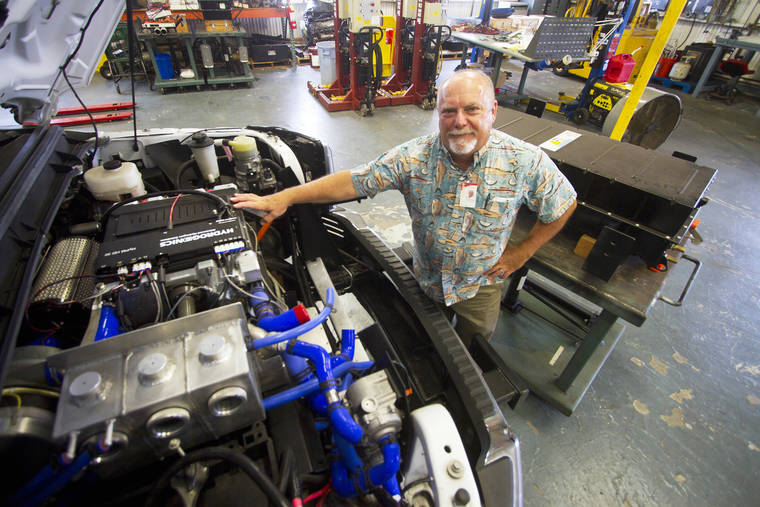HILO — There’s a lot of enthusiasm for zero-emission hydrogen-powered buses, but it’s a long road ahead before they become a staple of Hawaii County’s Hele-On fleet.
The County Council Public Works and Mass Transit Committee on Monday unanimously forwarded to one more council meeting Resolution 205, urging the county administration to acquire hydrogen buses to replace the diesel-powered ones that make up the fleet.
Puna Councilman Matt Kanealii-Kleinfelder, the sponsor of the measure, pointed to a 2006 council resolution asking the Department of Finance to study the procurement of high energy-efficient alternative fuel vehicles as part of its annual vehicle acquisition plans. He also noted a goal in state law to implement a plan starting in 2010 and ending in 2020, to transition the island of Hawaii to a hydrogen-fueled economy and to extend the application of the plan throughout the state.
“To me its a very viable alternative,” Kanealii-Kleinfelder said. “Let’s not wait to become another island to do it, but be the first island to do it. … Let’s make the shift now. … It’s coming; like it or not it’s coming.”
The Waimea Community Association town meeting will feature a basic Science 101 lesson about hydrogen as a transportation fuel by Blue Planet Research Director Paul Ponthieux. The meeting is 5:15-7 p.m. today in Waimea School Cafeteria.
Mass Transit Administrator Brenda Carreira remains dubious. She pointed to hydrogen buses, electric buses and double-decker buses, all received with great excitement but none yet successful where the rubber meets the road.
The double-decker buses, including one purchased new by the county for almost $1 million and another donated by Maui County, were failures. Carreira, who started Nov. 1, said one of the buses worked for five days and the other for three hours in the time she’s been administrator.
An electric demonstration bus that’s been loaned to the county sits at the Mass Transit baseyard because of concerns about liability, since the county doesn’t own it. It wasn’t immediately known how long it’s been there, as Carreira could not be reached for comment by press-time Wednesday.
The county was supposed to get three hydrogen buses, but so far, there’s only one. And “it’s not in any condition to go on the road as far as Hele-On,” Carreira said. A second bus that was supposed to come from Hawaii Volcanoes National Park has instead been donated to someone else, she said. And the third has yet to be dedicated to the county.
“I’m going to be held responsible. … I’m still continuing to fix things,” Carreira told the council. “If that’s where you guys want to go as a council … it’s not on me.”
With the system woefully low on working buses, the county’s been leasing Polynesian Adventure Tour vehicles at a high daily rate. Four new diesel buses should arrive in January or February, paid for with federal grants. The county also applied for a grant to purchase 10 40-foot buses. Those don’t specify that they have to be diesel, so they could be used for alternative energy transportation, Carreira said.
Diesel and electric buses cost from $300,000 to $600,000 each, compared to hydrogen buses that cost about $1 million, she said.
Currently, there are five broken-down buses that need new engines. Putting in diesel engines would cost about $50,000 compared to $400,000 for hydrogen retrofits because the entire drive train must also be removed, said Riley Saito, energy specialist with the county Department of Research and Development.
As far as infrastructure for the alternative energy vehicles, there’s a hydrogen production facility at the Natural Energy Laboratory of Hawaii Authority at Keahole Point. Building an electric fueling station at the county baseyard will run $2 million to $2.5 million, Carreira said. The bus currently uses a portable charging unit.
Carreira said once the hydrogen bus gets working, she plans to use it as the afternoon Waimea shuttle in order to test it on steep Kawaihae Road. That will be a good test of its ability to traverse the island’s geography. Hydrogen buses can run about 30 hours using their onboard fuel cells.
While council members cheered a move to green energy as the state nears its 2045 zero emissions target, several wanted to take a more cautious approach. Because the transit agency is receiving funds from the general excise tax surcharge that is for all transportation needs, Hamakua Councilwoman Valerie Poindexter wanted to make sure there is money left for roads as well.
“We don’t want all the GET to go to mass transit,” Poindexter said. “The reason was to help with the road issues. … I don’t want you sucking it all up. No sense get buses if our roads gonna bus it up.”

